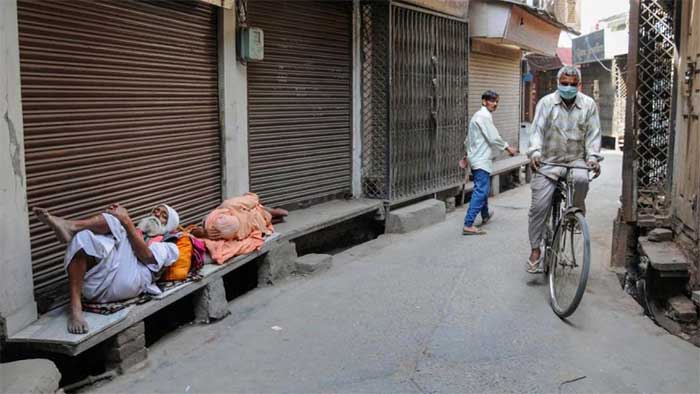
In the 21 day run-up period up to the start of lockdown, the average rate at which the COVID-19 cases were doubling was calculated to be 4.64. We assessed data provided by Union Ministry of Health and Family Welfare (MoHFW), Government of India (as compiled on Wikipedia: COVID-19 pandemic in India – last accessed on 06.05.2020 at 4.29 p.m.). It details the number of cases, deaths on a daily basis with effect 30 January, 2020 onwards. It has four columns viz. date, graph, number of cases (with %); number of deaths (with %). We would deal firstly on the number of cases three week prior to the lockdown viz. 4 March, 2020 to 24 March, 2020.
Simple Methodology
On 4 March, 2020 the number of cases in India was 28. The doubling of these 28 cases took place between 10 March and 11 March i.e. when the number of cases was 50 and 60 respectively. We entered the figure of 6-7 days in Column ‘C’. We repeated this exercise through the 21 day period up to the day just before the start of lockdown viz. 24 march, 2020.
Calculating the exact number of days in which cases doubled (Column ‘D’)
Now 6 days after the number of cases was reported to be 28 the number had reached 50; and seven days after the number of cases was reported to be 28 the number reached 60. Thus 10 cases were reported in that one day period, Day 6-Day 7. And 6 cases would get reported in 0.6 days. Hence the figure of 56 would be reached in 6+0.6 day = 6.60 days. This was entered in Column ‘D’.
The results are tabulated below:
TABLE – I
| Column ‘A’
Date |
Column ‘B’
Number of cases |
Column ‘C’
Number of days in which cases doubled |
Column ‘D’
Exact number of days in which cases doubled |
| 4 March | 28 | 6-7 | 6.60 |
| 5 March | 30 | 6 | 6.00 |
| 6 March | 31 | 5-6 | 5.14 |
| 7 March | 34 | 4-5 | 4.57 |
| 8 March | 39 | 4-5 | 4.57 |
| 9 March | 44 | 5-6 | 5.15 |
| 10 March | 50 | 4-5 | 4.61 |
| 11 March | 60 | 5-6 | 5.26 |
| 12 March | 74 | 5-6 | 5.78 |
| 13 March | 81 | 5-6 | 5.50 |
| 14 March | 84 | 4-5 | 4.77 |
| 15 March | 110 | 4-5 | 4.94 |
| 16 March | 114 | 4-5 | 4.05 |
| 17 March | 137 | 3-4 | 3.55 |
| 18 March | 151 | 2-3 | 2.85 |
| 19 March | 173 | 2-3 | 2.68 |
| 20 March | 223 | 4-5 | 2.79 |
| 21 March | 315 | 4-5 | 4.27 |
| 22 March | 360 | 4-5 | 4.18 |
| 23 March | 468 | 5-6 | 5.15 |
| 24 March | 519 | 5-6 | 5.06 |
Total: 97.47
The average rate of doubling of cases for this 21 day period = Sum-total of figures in Column ‘D’ divided by the number of days i.e. 21. Thus 97.47/21 = 4.64.
We repeated the exercise for the three week period after the lockdown got started from 25 March to 14 April i.e. the end of first phase of lockdown.
TABLE – II
| Column ‘A’
Date |
Column ‘B’
Number of cases |
Column ‘C’
Number of days in which cases doubled |
Column ‘D’
Exact number of days in which cases doubled |
| 25 March | 606 | 4-5 | 4.82 |
| 26 March | 694 | 4-5 | 4.93 |
| 27 March | 834 | 4-5 | 4.61 |
| 28 March | 918 | 4-5 | 4.01 |
| 29 March | 1,024 | 3-4 | 3.91 |
| 30 March | 1,251 | 3-4 | 3.90 |
| 31 March | 1,397 | 3-4 | 3.47 |
| 1 April | 1,834 | 4-5 | 4.12 |
| 2 April | 2,069 | 3-4 | 3.79 |
| 3 April | 2,547 | 4-5 | 4.62 |
| 4 April | 3,072 | 5-6 | 5.31 |
| 5 April | 3,577 | 5-6 | 5.51 |
| 6 April | 4,281 | 6-7 | 6.12 |
| 7 April | 4,789 | 6-7 | 6.15 |
| 8 April | 5,274 | 6-7 | 5.81 |
| 9 April | 5,865 | 5-6 | 5.82 |
| 10 April | 6,761 | 6-7 | 6.70 |
| 11 April | 7,529 | 7-8 | 7.20 |
| 12 April | 8,447 | 7-8 | 7.50 |
| 13 April | 9,352 | 7-8 | 7.78 |
| 14 April | 10,815 | 8-9 | 9.94 |
Total: 116.02
The average rate of doubling of cases for this 21 day period post lockdown = Sum-total of figures in Column ‘D’ divided by the number of days i.e. 21. Thus 116.02/21 = 5.52.
Some pertinent observations:
Out of the 21 day period – before and after lockdown – there were 11 days when there was no difference in doubling rates e.g. (See Table I & Table II)
- On 1 day the doubling rate was 3-4 days for both pre and post lockdown period.
- On 6 days the doubling rate was 4-5 days for both pre and post lockdown period.
- On 3 days the doubling rate was 5-6 days for both pre and post lockdown period.
- On 1 day the doubling rate was 6-7 days for both pre and post lockdown period.
- The average of doubling rate three weeks prior to lockdown was 4.64; it increased marginally to 5.52 three weeks post lockdown. The fact that lockdown period has been extended as phase II and phase III is the best evidence that very little, if anything got achieved in phase I.
- Regarding the timing of start of lockdown on 25 March, 2020.
A cursory look at Table I, Column ‘D’ will reveal that doubling rate on 18th, 19th and 20th March was 2.85; 2.68; 2.79 respectively. For the uninitiated it may be mentioned that lower the doubling rate, faster the pace of the spread of virus. Prior to 18th March (See Table I, Column ‘D’) the doubling rate was 6.60 to 3.55 from 4 March to 17 March. Thus the doubling rate on 18 March should have got the guns rolling – to use the militarist jargon followed assiduously worldwide by doctors-bureaucrats-politicians alike. True, to get at the doubling rate of 18 March one had to wait till 21 March when the number of cases stood at 315. Thus 151 cases of 18 March doubled to 302 by 21 March. The clampdown should have been announced on 21 March at whatever time the reading of 315 got available. The medical scientists sitting in the war-room (presumably situated in the office of the Union Home Ministry) should have given the green signal for the lockdown. By 23 March the decision makers would have the figures of 2.68 and 2.79 as the doubling rates for 19 March and 20 March staring on their faces, No dissent was needed because for three consecutive days viz. 18 March, 19 March, 20 March the doubling rate was hovering around 2 plus but under 3. No government anywhere in the world would consciously wait for the doubling to reach the figure of 1, because this means cases would double everyday with respect to the previous day’s cases; it would be disastrous to wait for the doubling rate to become 1. The doubling rate of 2 plus signals time for clampdown particularly when for three consecutive days it is stagnant at 2 plus. Why was clampdown not ordered on 21 March and certainly not later than 23 March?
In such situations a delay of even one to two days means the virus is being given a free rein and to hide the real reason for increasing number of COVID-19 cases in India, the Tablighi Jamaat congregation got used as an alibi.
[Dr. P. S. Sahni is an independent medico-legal researcher and member of ABVA. With research inputs from Shobha Aggarwal. Email: [email protected]]
SIGN UP FOR COUNTERCURRENTS DAILY NEWS LETTER








































